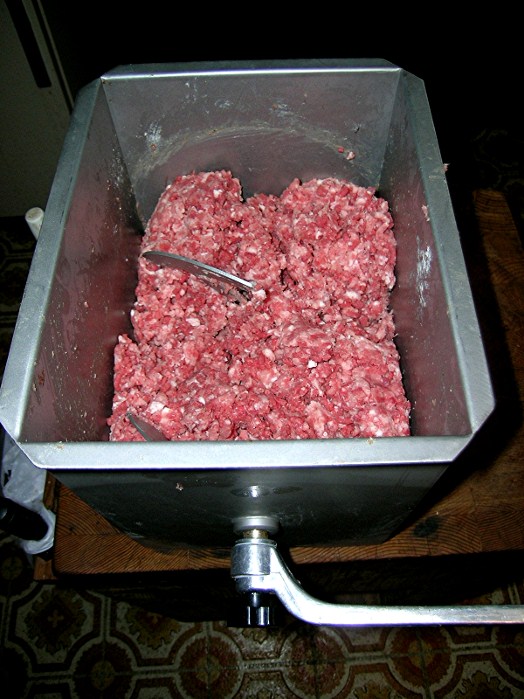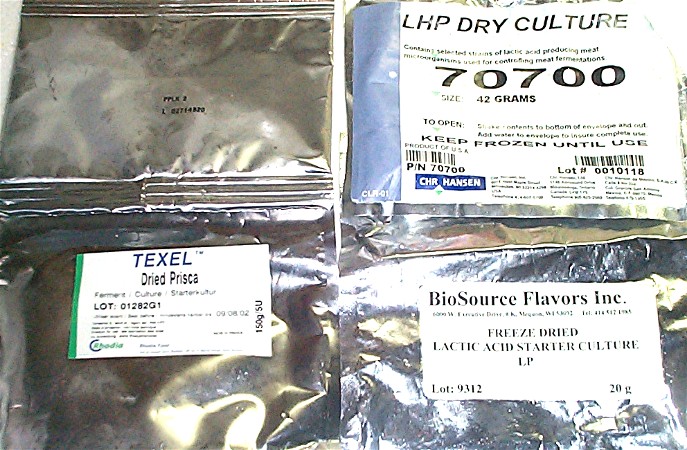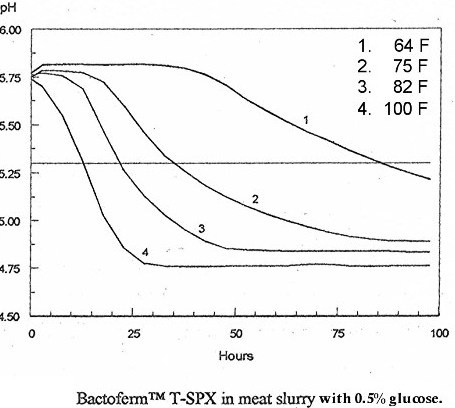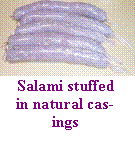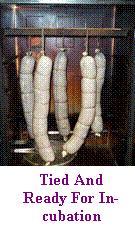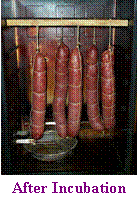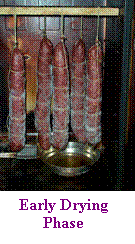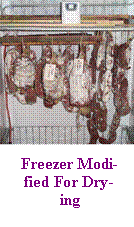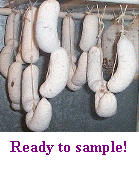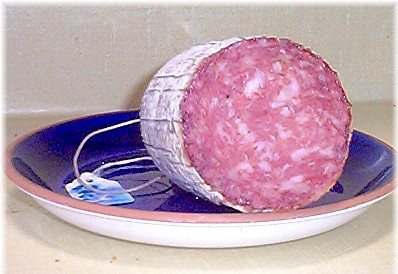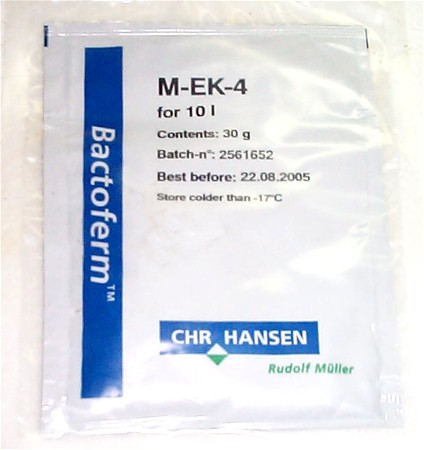|
The Production of Fermented Dry Salami:
Background: Salami production has always been due to the presence and life activities of lactic acid bacteria in the meat and the meat preparation area. In the past, salami making was thought of as an art because sausage makers did not have an understanding of the effect of bacterial growth in the meat paste. Meat was chopped, salt was added along with spices and the salami maker had a protocol to follow that produced an edible product...most of the time! The indigenous bacterial contaminants worked their "magic", but the results were not always successful. If the bacteria activity resulted in a high pH, spoilage bacteria could grow and, in the worse case, pathogenic bacteria had a population explosion in the salami.
With research in the academic institution, bacterial growth and fermentation
processes we elucidated and "starter bacterial cultures" became available
for commercial production which resulted in a uniform and consistent
product. With the introduction of starter cultures, salami production became
less of an art and more of a science. It is now know that a large
family of bacteria, the lactic acid family, is essential for good,
consistent product development. However not all lactic bacteria are
desirable; some prefer to live in an oxygen rich environment, while other
prefer anoxic environments. It seems that this group has very specific
substrates that they rely on for food. Some produce buttermilk from
milk sugars and others produce cheese and others produce yogurt. Some like
certain starches and produce the flavor complexity of sour dough bread,
others like wheat and barley and contribute to the flavor of beer,. A small
group prefer to live in ground meat and convert glucose to lactic acid!
Those are the ones we use to make salami!
The Meat Paste:
Regional traditions dictate the types of meat and fat used in the
manufacture of salami. I prefer to use pork shoulder butts when the recipe
calls for pork, beef chuck when beef is used. For fat, I prefer to use what
is termed pork back fat, which is the fat trimmed of the top of loin area
along the back of the pig; another choice would be "fat bellies", the same
cut of meat used to make bacon. Other choices are pork jowls and beef
cheeks! As mentioned previously the pork meats should be pre-frozen
according to the schedule outlined by the USDA--in the business, this is
referred to "certified pork"--which means that the pork has been certified
by the on-site government meat inspector and meets all the USDA
requirements.
Remove and discard as much sinew as possible from the meats. The dimensions
of the grind will depend upon the style of salami you wish to make; for
example,
Meats that are chopped or are a medium or large grind can be mixed fairly
aggressively since the final product will not have a homogeneous texture of
fat to lean. However, the fat in fine ground pastes can become
excessively smeared during the mixing and blending stage if it is not kept
very cold. Of the many variables in making salami, one of the most important
is the temperature of the fat and the meats. The meats used in salami making
should be kept at a temperature range of 36°F to
Sugar:
Essential to the process of making fermented dry cured sausages is the
presence of sugar in the form of glucose (often called dextrose). Glucose
is a sugar that contains carbon hydrogen and oxygen atoms with the general
formula of C6H12O6
The lactic acid bacteria (LAB) get their name from the fact that they
convert glucose to lactic acid, which in turn lowers the pH in the meat
mixture. This has the effect of inhibiting the growth of less
desirable bacteria. Sugar in animal muscle is in the form of a starch
called glycogen and is not immediately available to the bacteria as a food
source so glucose must be added to get the process going; however, other
carbohydrates may also be added in some formulations such as maltodextrin,
lactose or sucrose. All these carbohydrate can easily be broken down into
glucose by LAB.
GLUCOSE
[
LACTIC ACID + ENERGY
C6H12O6
[
2 CH3-CHOH-COOH + 2 ATP
Salt: The
salt is essential because it is involved in the biochemical activities we
call curing as well as the inhibition of some microorganisms found in the
meat. Because LAB are salt tolerant, they get a jump start over less
desirable salt intolerant microorganisms. Contrary to common belief, it is
the salt the only ingredient that is essential to "cure" or preserve the
meat, not the nitrite/nitrate "curing salts". The salt makes the proteins
in the meat soluble, causing a sticky film (myosin) to form around the fat
particles which in turn creates a stable emulsion. The addition of salt to
the meat alters the osmotic pressure of the muscle cells and causes the
dehydration of the meat paste which also prevents growth of food-spoilage
microorganisms. The use of salt alone would produce a harsh, dry and
overly product with an undesirable dark color, therefore other additive to
the meat paste help improve the appearance and taste of the product. The
usual amount of salt added is generally between 2-3% by weight.
Nitrite:
In
addition to the salt, nitrite is added for the inhibition and the
selection certain bacteria found in the meat. In dry cured products, a
mixture of both nitrite and nitrate are added to the meat. As stated on
the "INTRODUCTION" page, it is desirable to select and add lactic acid
producing bacteria to the salami paste. more on this topic follows. You
sometimes see formulas that call for saltpeter (potassium nitrate).
Saltpeter concentration is difficult to control in small amounts and it is
very easy to overdose. The current trend is to move away from saltpeter
and use sodium nitrite/nitrate mixtures. In reality, the nitrate, to be
useful in curing, must be converted to nitrite...this is accomplished by
bacteria (Micrococcus, for example) present in the meat paste.
Nitrite is used up quickly in the curing process so a mixture of nitrate
and nitrite is added to dry-cured meats to ensure a supply of nitrite in
the later stages of maturation. In addition it keeps the meat an appealing
red color. Nitrite reacts with myoglobin and is an essential for the
development of characteristic red color in preserved meats. It is
quickly used up so another sodium compound (nitrate) is added along with
the nitrite. An enzymatic reaction (caused by nitrate reductase)
converts nitrate to nitrite. The reductase is produce by a common
bacterium (Micrococcus) found in the meat or the bacteria may be added
during production.
nitrate reductase
Sodium nitrate
[
Sodium nitrite
Na+ [NO3]-
[
Na [NO2]-
The nitrite is particularly effective in the inhibition of Clostridium
bacteria, which causes botulism.
This microorganism produces a very powerful neurotoxin (nerve poison)
that is the most toxic of all naturally occurring substances. The incidence of the disease is low, but the disease is of considerable
concern because of its high mortality rate if not treated immediately and
properly.
When it is ingested it causes paralysis. if left untreated
12 or more hours, the lungs can be paralyzed and death occurs. Botulism is usually associated with
consumption of the toxin in food. It can exist as a living organism or
spore in contaminated food. The animals most commonly
affected are wild fowl and poultry, cattle, horses and some species of
fish. Sausages, meat products, canned vegetables and seafood products have
been the most frequent vehicles for human botulism. The organism is very resistant to
heat and other treatments. Because naturally occurring levels of spores
are low, cellular growth is required to produce the toxin. C.
botulinum can
grow under the
anaerobic (no oxygen) conditions found in dry-curing sausages and salami. The neurotoxin is heat labile and can be destroyed if
contaminated foods are heated at 80°C (176oF) for 10 minutes or
longer.
Starter Cultures:
Many foods that we enjoy, such as, cheeses, yogurt, beer, and sourdough
bread to name a few are the result of bacterial fermentation. The lactic
bacteria used in salami making are salt tolerant and produce lactic acid
from the glucose (dextrose) in the meat paste, which has the effect of
lowering the pH (or raising the acidity).
I recommend the use of a starter culture in order to control the myriad of
microorganisms that may be present in ground meat, especially
food-spoilage and pathogenic microorganisms. The purpose for using them in
my opinion is twofold: they enhance product safety and enhance product
quality. The environment of the meat is quickly acidified making it a
hostile place for pathogenic and spoilage bacteria to grow. The rapid
increase in acidity inhibits the water bind ability of the meat and makes
for a more consistent drying process. See the discussion of water-activity
(Aw) in the "TIPS" page.
Starter cultures can be difficult to find in small quantities. At one time
they were available only for commercial use, but now they are now
available in small packets for the home sausage maker. I currently use a number of freeze dried starter cultures produced by Chr.
Hansen North America. They are available from several sausage making
suppliers and can be purchased over the internet. Each type produces
slightly different subtle flavors and can be used through a specific range
of incubating temperatures.
I’ve used several species Pediococcus, Staphlococcus, and
Lactobacillus. These microorganisms are available in various mixtures
and I refer you to the charts on my "INTRODUCTION" page. My choices are
based on their optimum incubation temperature
and flavor production. I like Bactoferm LHP whose optimum growth is
obtained between 80-100ºF. It contains a mixture of Pediococcus
acidilactici and Pediococcus pentosaceus).
Bactoferm F-RM-52 shows optimum growth between 70-90ºF.
It is a fast acidifier that is a mixture of
Lactobacillus sakei and Staphylococcus carnosus.
Bactoferm T-SPX is my favorite for northern Italian style salami and shows
optimum growth at 75oF. It is a mixture of
Pediococcus pentosaceus
and
Staphylococcus xylosus). The
Lactobacillus and Pediococcus in these last two mixtures are
the acid producers and the Staphlococcus is the flavor and nitrate
reductase producer.
Spices:
The purpose of the spices is to impart the
desired the taste and aromas that the salami maker prefers. These aromatic
plant substances can be used in their natural form, oils or extracts and
give color or flavor to the product. They can be used whole, cracked or
ground. Spices like garlic and pepper contain antioxidants and help
prevent rancidity. In the majority of the cases, Italian salami is often
flavored with black pepper, cracked or ground, wine infused with crushed
garlic, red pepper or fennel seeds. Other formulations may have mace,
cinnamon, clove or nutmeg. It is absolutely essential that you use fresh
spices for consistent results. If your ground spices are
more than 6 months old, through
them out and purchase new ones. It is always better to
purchase whole, un-ground spices and grind them yourself as
needed...you'll be surprised by the difference!
The meat paste is stuffed into casings and tied. The casing used must
allow moisture to escape the salami throughout the manufacture. The
choices for casings are astonishing. They fall into two categories:
natural and artificial. The artificial casings can be collagen (some
edible others not) or fibrous; the natural can be intestine, bladder,
stomach or esophagus from beef, pork or sheep. In Europe, horse and
donkey innards can also be used in some countries.
For salami, I prefer to use a natural casing called a "beef middle". The
size I use makes salami of 2-1/2 inches in diameter, stuffed. They are
packed in salt and will keep for many months in the refrigerator. I like
to use natural casing for two reasons: they give the salami an "old world"
look and because the are edible, they contribute to the overall taste of
the salami. I also believe the salami dries more evenly and consistently
with natural casings. If you're going to spend money for casings,
you might as well get the kind you can eat! The advantage of
artificial casings are that they are easy to store, they are a consistent
size, and they don't smell!
The Maturation
Process:
In my opinion, the maturation of salami can be thought of being subdivided
in three distinct phases: Curing, Incubating, Drying...all
of which require different temperatures and relative humidity conditions.
Depending upon the type of product that is intended, this process may last
21 or more days
Once the
meat is ground or chopped and all the additives have been added and mixed,
the maturation process of salami production can be thought of being
subdivided in three distinct phases: Curing, Incubating
(Fermentation), and Drying (Aging); each of these phases
require different conditions of temperatures and relative humidity.
Depending upon the type of product that is intended, this process may last
21 or more days. |
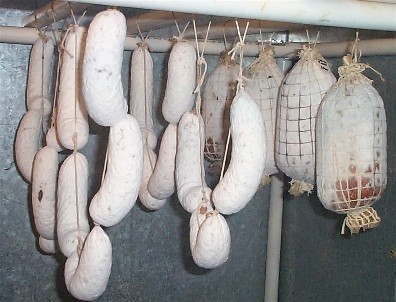

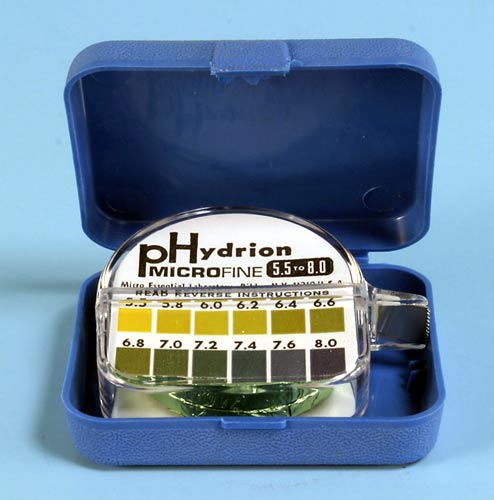 So many steps are involved in producing a successful product
that you must keep written records relating the meat to fat ratio, size of
the grind grinder plate, temperature, etc. If you have access to a pH meter
or pH paper, it is helpful to record the pH at this time and again after
fermentation is complete. There are many types of pH papers on the
market. Be sure to get one with a narrow range for a more accurate
reading...generally the best are measure pH from 4.5 through pH 7.5 (5.5-8.0
is OK) Prices vary a lot but you shouldn't have to pay more than $6 a roll!
These notes will be invaluable in evaluating the final product The
preparation of the meat paste begins with grinding the raw materials.
So many steps are involved in producing a successful product
that you must keep written records relating the meat to fat ratio, size of
the grind grinder plate, temperature, etc. If you have access to a pH meter
or pH paper, it is helpful to record the pH at this time and again after
fermentation is complete. There are many types of pH papers on the
market. Be sure to get one with a narrow range for a more accurate
reading...generally the best are measure pH from 4.5 through pH 7.5 (5.5-8.0
is OK) Prices vary a lot but you shouldn't have to pay more than $6 a roll!
These notes will be invaluable in evaluating the final product The
preparation of the meat paste begins with grinding the raw materials. 